MARKETING
15+ Must-have SaaS Tools for Startups in 2022

According to a recent McKinsey & Company report, the SaaS market is expected to grow to nearly $200 billion by 2024.
Time marches and technology evolves. Gone are the days when all business operations required manual intervention. Being a part of a technologically advanced business era, Automation is no more a buzzword, but a necessity for businesses to succeed.
And when we talk about the automation of business processes, ‘’Software as a service’’ SaaS needs no introduction. Any business that wants to make the most out of technology and favors cost-effective solutions for their IT needs, opts for SaaS tools to automate processes.
Like any SaaS consultant will tell you, Investing in the best-suited SaaS tools can not only remove any kind of friction from work and user flow but also give businesses a competitive edge. Thus, if you haven’t thought of a SaaS stack for your business, you are missing out on a lot of tech advancements that can take your business to the next level.
Now before we learn about the must-have SaaS tools to create your business SaaS stack, let’s look at some important insights about SaaS tools and their perks.
An Introduction to SaaS Tools
Software as a service (SaaS) tool in simpler terms is a software distribution model in which a software provider hosts their software applications on the cloud and makes the copy of that software available to end-users over the internet while charging a fixed subscription fee. These tools are easily accessible on any device’s web browser with an active internet connection and don’t require any physical installation.
Moving on, let’s look at some key features and benefits of SaaS tools along with some key SaaS terms that you should know.
Benefits of using SaaS tools for Business
- Easy to access, use and maintain
- Lower cost associated
- Continuous Functional Improvements
- Highly Scalable & Flexible
- No Hardware Investments
- Enormous System compatibility
Key Features of SaaS Tools
- Remote Access: The most useful feature of SaaS tools is that they are easily accessible on any device with just a few clicks and taps, the only requirement is an active internet connection.
- Subscription-based Payment: SaaS tools are the most cost-effective way of automating business processes. As with most SaaS tools you only have to pay for what you use, billing is done on a monthly, quarterly, or yearly basis based on what feature you choose to utilize.
- Easy to implement and use: SaaS tools don’t require any physical setup or much time to get started with the software. All it takes is easy signup, subscription, and you are all set to start leveraging the respective SaaS tool.
- Highly Scalable: The best part of having a SaaS tool is that with the continuous functionality advancements the software keeps on improving. And as your business grows you’ll always have an upgrading option.
- Security: Any business irrespective of its size prioritizes the security of its data first, and with SaaS tools, security is ensured with encryption and restricted user access.
Common SaaS Terms you should know
- Vertical SaaS: SaaS solutions render a target to a specific industry only. This software is created specifically for a particular industry catering to their needs, goals, and pain points. For example, Guidewire software, a SaaS tool that specifically caters to the Insurance business.
- Horizontal SaaS: SaaS solutions that are intended to cater to the benefit of people across different industries with varied needs and end targets. For example, Slack – a communication software that can be used by anybody irrespective of their industry.
- Packaged SaaS: SaaS product that is designed for certain business goals and processes. For example, Salesforce is an all-in-one CRM software.
- Collaborative SaaS: SaaS tools that help teams collaboratively work together without hassle. For example, Basecamp is a renowned project management tool.
Now that you have a fair idea of SaaS tools, let’s get on to exploring the must-have SaaS tools for your business according to the business processes.
Must-have SaaS Tools in 2021
Project Management SaaS Tool
Businesses often juggle with multiple clients, projects, and tasks. Managing and catering to multiple clients and projects single-handedly at some point and time can lead to a lack of team collaboration, missed deadlines, chaos, and disorganization, which certainly is not acceptable for any business that aims to succeed.
Especially with the work from the home era setting its pace, working remotely, and collaborating with the team has become a hassle. Often due to lack of management and collaboration, deadlines are missed, work is hampered and all it leads to is a lost client and negative reputation.
Having an all-in-one project management tool that can streamline the management and collaboration processes for multiple projects can be an asset that yields commendable customer experience.
Benefits of Project Management Tool:
- Efficient Resource Planning
- Project Planning and forecasting
- Improved Team Collaboration
- Enhanced Productivity
- Improved Planning, scheduling, and risk mitigation
With that said, you might have an idea of what exactly is a project management tool and how it can benefit a business. Now moving forward let’s look into the best project management tools that you can utilize and streamline the management of multiple projects and tasks.
1. Basecamp
With 3.5 Million accounts and 22 years of service, Basecamp is a renowned project management tool. The reason behind Basecamp ruling the project management realm is that basecamp centralizes all the processes making it easy for every individual in the organization to look, understand and play their part in each project.
Having a centralized way of communicating, keeping files, handling project approvals, deadlines, feedback, and streamlining projects is all it takes to cater to multiple project clients while offering them a greater experience working with you.
Features:
- Easy to manage
- Responsive Interface – can be accessed on the Web, Android, or iOS
- Effective team collaboration with employee tags
- Centralized approvals and feedbacks
- Easier project communication with group chats
- Message boards, schedulers, To-do lists
- Secure and effortless document sharing
- Free 30-day trial
Pricing: $99/Month
2. Zoho Projects
Another well-known project management tool is Zoho Projects. Similar to basecamp, Zoho projects streamline business processes right from project planning up to the execution of the project.
Catering to all the needs of a business, Zoho projects play a major role in planning multiple project activities, assigning work, managing balanced resources, and collaborating with the team members.

Features:
- Impressive UI
- Task Automation & Management
- Project Time Tracking
- Effective Team Collaboration
- Gantt Charts and Reports
- Project Administration & Tracking
- Responsive Online Software
- Easier Integrations
Pricing: $10 per user/Month
3. Narrato Workspace
Narrato Workspace is a content creation and workflow management tool that helps streamline your content creation process. The software provides a powerful content editor that offers suggestions for improving content quality. Collaboration on content tasks is also very convenient, with the entire team coming together on the platform.
Assigning tasks, organizing content projects under folders, tracking task status and delivering projects to clients on the platform are simple too. The “Client” user role on the platform lets you share work with clients and gather feedback, which can be quite useful for content and web design agencies.

Features:
- Grammar and readability suggestions + AI assisted writing
- Customizable content templates
- Guidelines repository for reusable project guidelines
- Folders, content calendar and Kanban boards for organizing/ tracking projects
- Customized roles and access for managing team members, freelancers and other stakeholders
- In-line comments on tasks and messaging on platform for easy collaboration
- Publicly shareable links and WordPress publishing for easy content delivery
Pricing: Presently, you can create a free account and try out the platform at no cost for 6 months.
4. ProofHub
ProofHub is an all-in-one project management and team communication solution for teams of all sizes in a variety of industries. It assists project managers in breaking down complicated projects into small, achievable tasks and subtasks. You can create and assign tasks, set estimated time, track progress, and work with other team members easily in one location.

Create custom fields, check your workflow in multiple views, chat with individuals or groups, conduct real-time discussions, save and proof digital files using the proofing tool, review project reports, and much more. ProofHub is a simple, cost-efficient, and effective project management tool.
Features
- Effective task management with start and due dates
- Efficient team collaboration features like discussion boards and notes
- Easy to use Custom fields to sort and manage information
- Robust Time tracker
- Online proofing to streamline reviewal process
- In-built chat application
- Kanban boards and Gantt charts
- Detailed Project reports
- White labeling
Pricing: $89 per month (Flat price)
CRM – Sales Automation SaaS Tool
CRM (Customer Relationship Management) is a system intended to streamline and improve the relationship and coordination with businesses’ existing customers, help find new prospects, and retain the former customers.
A CRM SaaS tool in simpler words encompasses all the activities, strategies, and technologies to cater, communicate and manage both the existing as well as the potential customers.
Benefits of CRM SaaS Tool:
- Improved Customer Relations
- Increased Customer Revenues
- Maximized Productivity and organizational performance
- Better Informational Communication
- Efficient Analytical Documentation and reporting
Now that you have an idea of what a CRM is and how helpful it can be for your business, let’s move on to explore the best CRM SaaS Tools available for businesses to leverage.
1. Salesforce
When it comes to CRM, salesforce is a renowned name. It offers a centralized platform to streamline, organize and manage marketing, sales and customer support.
Salesforce enables businesses to target different audiences, with the help of smart automation intended to cater to every lead and customer activity, while also helping internal teams work collaboratively while delivering consistent results in the best interest of customers.

Features:
- Intuitive UI/UX
- Robust and flexible security architecture
- AI-augmented analytics
- Enterprise-level collaboration
- Intelligent search feature
- Metadata Architecture
Pricing: $25 per user/month to $300 per user/month
2. Zendesk Sell
Another well-known CRM SaaS tool is Zendesk. Similar to Salesforce, Zendesk also offers an intuitive centralized platform to manage and nurture every lead prospect that you want to cater to.
Zendesk Sell is well-equipped with robust sales prospecting functionality that intends to leverage an untapped market of over 200 million professionals. Businesses irrespective of their sizes prefer Zendesk Sell to identify prospects and nurture the lead until it becomes a customer.

Features:
- Email tracking and automation
- Sales dashboard and reporting
- Responsive CRM with Intuitive UI
- Automatic dialer with text capability
- Out-of-the-box integrations and analytics
- Contact and Lead management, discovery, and verification
Pricing: $99 per user/month (Billed Annually)
Marketing Automation SaaS Tool
Now that we have done learning about sales automation tools, the next important automation tool that needs consideration is the Marketing Automation tool.
Marketing Automation Tool primarily is intended to centralize the various marketing activities including emails, blogs, social media, web pages, etc, and deliver the right content, at the right time, to the right customers, in turn nurturing their trust for the brand. Investing in a competent marketing automation tool can help businesses focus on what matters, i.e., an overall marketing plan and lead generation.
Benefits of Marketing Automation Tool:
- Balanced Resource Allocation
- Save Time & Effort
- Improved Customer experience
- Increased Productivity
- Multi-channel campaign management
- Increase ROI
- Automated Detailed Reports
- Improved customer retention
Moving forward, let’s look at the best marketing automation tools that you can leverage for your business.
1. Marketo
Marketo is the best-in-class automation software available for businesses to generate, nurture and grow leads.
Owned by Adobe, Marketo is a renowned SaaS tool built to help businesses automate and manage their marketing engagements and workflows.
Marketo empowers businesses to engage the right customer by leveraging rich behavioral data of potential customers, build and scale the best-suited brand marketing campaign and finally paving way for business opportunities and an uplifting customer experience.

Features:
- Identifying, Nurturing & Managing Leads
- Bi-directional CRM Integration
- Email & Consumer Marketing
- Web Activity tracking
- Marketing Calendar
- Campaign Dashboards and Reporting
- Save Time, Costs, & Efforts
- Increased Productivity
Pricing: starts at $1,195/month
2. Eloqua
Known as Oracle Eloqua Marketing Automation Tool, this is another renowned name when Marketing automation is concerned. Primarily Eloqua helps in strategizing and implementing closed-loop marketing and sales activities while managing cross-channel B2B marketing campaigns.
This centralized platform leads to seamless nurturing of leads across each stage of the buying process with competent campaign design, advanced lead scoring, real-time analytical data, and integrated sales tools.

Features:
- Dynamic Campaigns
- Real-time activity tracking
- Increased productivity
- AI-enabled Lead management
- Seamless Revenue analysis
- Compatible workflow
Pricing: starts at $2000/month
Business Communication SaaS Tool
When we talk about business communication, numerous aspects come into consideration. First of all, business communication can be vertical and horizontal. When we say vertical, it means internal lateral communication between the employees and superiors. Whereas horizontal communication is the communication between employees and teams.
Transparent communication in an organization can lead to a much-streamlined workflow and collaboration between teams as well as individuals. Especially in the work from home era, organizations must maintain an effective channel of communication to continue business functioning without any hassle. And this is why business communication tools have seen an increase in demand.
Benefits of Business Communication Tool:
- Real-time communication
- Productive meetings and conversations
- Improved employee engagement
- Easy data sharing
- Effortless task Management
- Increased productivity
In today’s time, business communication tools need no introduction. So, let’s get to explore the best business communication tools that are available for businesses.
1. Slack
It is a renowned business communication SaaS tool with more than 12 million daily active users and around 7,50,000 organizations leveraging this enormous communication tool.
The primary aim of Slack is to cut down the hustle of communicating through longer mail trails by offering a synchronized platform for the entire organization to communicate, share files, plan projects, have discussions, and maintain a track record of tasks and strategies.

Features:
- Messaging, Voice & Video calls
- Organized channels for specific conversations
- Can Pin messages and links to channels
- Easy Access, Management, and tracking of documents
- Advanced search options
- To-do list and notes facility
- Streamlining your sidebar
- Subscribing to RSS feeds
- Robust reminders and navigations
Pricing: Free to $12.50per active user, per month (billed annually)
2. Flock
Flock is one of the best business communication tools that enable seamless communication between superiors and associates.
Flock offers a robust online platform that works on all devices and OS, and acts as a virtual workplace enabling direct messaging, group messaging using smart channels, voice, and video calls, screen sharing, file sharing, etc.

Features:
- Direct messaging & Video conferencing
- Integrated search & Guest Users
- File sharing & To-dos
- Reminders, Text & Voice Notes
- Light & Dark mode theme
- Multiple App integrations
Pricing: Free to $4 per licensed user/month
SaaS-based Workforce Management Platform
HR departments often find themselves overloaded with a huge set of employee-related responsibilities, which increases with employee strength. Moreover, in this highly competitive era, it is crucial to effectively administer all the workforce activities to give them the best experience.
Handling it alone with manual practices becomes more time-consuming and tedious work to perform, which proved to be more mind-numbing in the remote working environment. This approach brings nothing more than chaos, inefficiency, unproductivity, high cost, data manipulation, data inaccuracy, and burden to HR managers.
A unified human resource management tool streamlines all the daily tasks and gives freedom from the spreadsheet-based workflow to all the companies. Also, this automated solution is preferable for the tech-savvy workforce to perform their work in this digitally evolving era.
Benefits of Human Resource Management Software:
- Reduces paperwork
- Improvises employee management
- Boosts communication
- Streamlines administrative tasks
- Centralizes all the critical data
- Generates error-free results
Let’s now move forward and look at the highly used Human Resource management tools to adopt in your business to build a more empowering and effective workplace.
1. factoHR

factoHR is a famed identity in providing cloud-based human resource management solutions to small, medium, and large-sized companies for automating their daily HR operations with its simplified solutions.
It is a perfect plug-n-play, mobile-first solution for every company seeking assistance in handling the overall HR tasks. Beginning from recruitment to FnF (Full and Final) settlement, every stage is handled well and more effectively with this solution. Companies can better administrate talent management, enhance employee engagement and productivity, ensure compliance management, and many more with this SaaS tool.
Its easy and quick implementation functionality in a budget-effective manner makes this solution usable for 1500+ companies with 1.5 million employees onboard.
Features:
- Simplified dashboard functionality
- Hierarchical & configurable approval workflow
- Assisted by separate mobile application
- ESS portal for employees
- Performs mood analysis to keep employees engaged
- A single source of truth for your data
- Detailed report generation capabilities
- Provides analytical insights
Pricing: Starting at $40.80/month
2. Keka
Keka is an employee centric SaaS platform that combines HR, payroll, ATS and performance management in a single suite of tools. With Keka’s robust platform companies can seamlessly manage human resources processes.

Features:
- Payroll Management
- Performance Management
- Project Management
- Recruitment Management
- Reimbursement Management
- Shift Management
- Attendance management
- Bonus, Loan & Advances Management
- Document Management
- Email Integration
Pricing – Starting at $ 94/ month
Social Media Automation SaaS Tool
Now that we’ve looked into the SaaS solutions for 4 main pillars of the business i.e. Project Management, Sales, Marketing, and Communication, it’s time to explore SaaS solutions for the fifth most important aspect of a business – Social Media.
It is no news that Social Media Marketing is one of the most important parts of any business’s marketing strategy. And being time-consuming, Social Media Automation has become one of the integral parts of business processes. No marketer prefers to spare time every day to post content on different social media channels, and that is when they choose to opt for social media automation tools that make their content creation and sharing a seamless experience.
Benefits of Social Media Automation Tool:
- Saves Time & effort
- Improved Engagement
- Increased online presence
- Real-time Analytics
- Increased brand reputation
The best social media automation tools that you can leverage are:
1. HootSuite
The most renowned social media automation tool is HootSuite. Being an incredibly useful social media tool, Hootsuite enables marketers to syndicate as much content as they wish to share with their audience.
With advanced scheduling features, businesses and marketers can leverage this platform to share content, read responses, schedule messages, view statistics, and a lot more.

Features:
- Content Scheduling
- Content sharing across all major social platforms
- Insightful Analytics
- Social Media Listening
- Team collaboration
Pricing: $17 per user/Month to $610/Month
2. SocialPilot
SocialPilot is one of the best websites like Hootsuite that any business can leverage. SocialPilot offers businesses a seamless social media marketing journey that results in a greater ROI and brand recognition by empowering them with competent features that help them plan and implement their marketing strategy without hassle.
Along with social media automation and social media calendar, SocialPilot offers two unparalleled features: the in-built content curation tool and the White label solution. SocialPilot’s content curation tool helps you maintain the constant flow of relevant yet engaging content while with their White label solution, a business can personalize the experience they want to offer to their client. They can also market SocialPilot as their own social media software creating a flow of extra income.

Features:
- Content Curation
- Social Media Scheduling across all major social media channels
- Social Media calendar
- Bulk Scheduling
- RSS Feed
- Real-time Analytics
- Detailed Quantification of Social Media initiatives
- Personalized dashboards and emails
- Team & Client Collaboration
Pricing: $30/Month to $130/Month
Accounting SaaS Tool
Accounting is a crucial aspect of every business irrespective of its size or industry. Every business requires accurate data analysis. Investing in having a centralized SaaS tool that will help manage finances has become a common practice.
These accounting tools can range from being simple single-entry programs used for storing individual records, to more advanced accounting systems that enable business owners to effectively track finances, have detailed reports, and mitigate risks.
Benefits of Accounting SaaS Tool:
- Cost Saving
- Optimized business financial operations
- Easy to use
- Secured Database
- Automated record-keeping
- Simplified tax compliance
- Seamless expense management
Moving forward, let’s look at the best accounting SaaS tools you can utilize for the benefit of your business.
1. QuickBooks
With more than 7 million active users across the globe, Quickbooks is the #1 accounting software for businesses. A centralized platform where all of the business accounting data can be organized, sales can be tracked, invoices can be created and shared, finances can be tracked and planned. What else does a business need?

Features:
- Cloud Accounting
- Invoicing
- Online Banking
- Accounting Reports
- Cash Flow Management
- Time Tracking
- Accounting Reports
- Data Security
- Automatic Backups
Pricing: $12/Month to $90/Month
2. FreshBooks
Another efficient accounting software is FreshBooks with over 24 million users across the globe. Enabling businesses to experience seamless billing and tracking expenses this software is one of the most preferred account Saas tools.
One of the best features of FreshBooks is payment schedule time tracking. This one-of-a-kind platform enables businesses to set reminders for the unpaid invoices and keep a track of all the missed payments along with a detailed account of specifics.

Features:
- Invoices
- Payment Reminders
- Personalized invoicing
- Multi-currency billing
- Automatic Tax calculations
- Expense Tracking
Pricing: $7/Month to $25/Month
SEO SaaS Tool
Search engine optimization is no more a buzzword. Businesses today invest in SEO aiming to increase brand visibility and to attract new customers. Utilizing a SaaS Tool to automate business’s SEO is one of the smartest ways to pave the way for results and ROI.
Benefits of using SEO SaaS Tool
- Attract quality traffic to your website.
- Enhance conversion rate.
- Generate quality backlinks.
- Establish brand awareness.
- Drive traffic to website
- Improves website loading speed.
One of the best SEO SaaS Tool that you can leverage is:
Sitechecker
It is an all-in-one SEO platform. Get a full SEO analysis report on your website to develop the best SEO strategy and, as a result, improve your search engine visibility. You can easily analyze and fix SEO mistakes with Sitechecker’s practical tips. Site validation gives you a complete picture of all the SEO flaws of your site. Once you recognize them and fix them, you will have a chance to improve and increase your site’s ranking in search engines.

Features:
- Site Audit
- Site Monitoring
- Rank Tracker
- Backlink Tracker
- SEO Chrome Extension
Pricing: $23/Month to $79/Month
Bottom Line
We are a part of an extremely competitive business era, where a business can become big overnight and hit a rough patch the other day.
Staying well-versed with the advancements, trends, and updates is a necessity and time is the most precious commodity. Businesses are trying their best to level up with the industry leaders and among such cut-throat competition, if you are still investing time and resources in business operations that can be automated, then you’re certainly losing the pace.
Do not overthink, now that you know what all business processes can be automated. Upgrade yourself to a SaaS stack and see how your business thrives through the competition.
Source link
MARKETING
How to create editorial guidelines that are useful + template
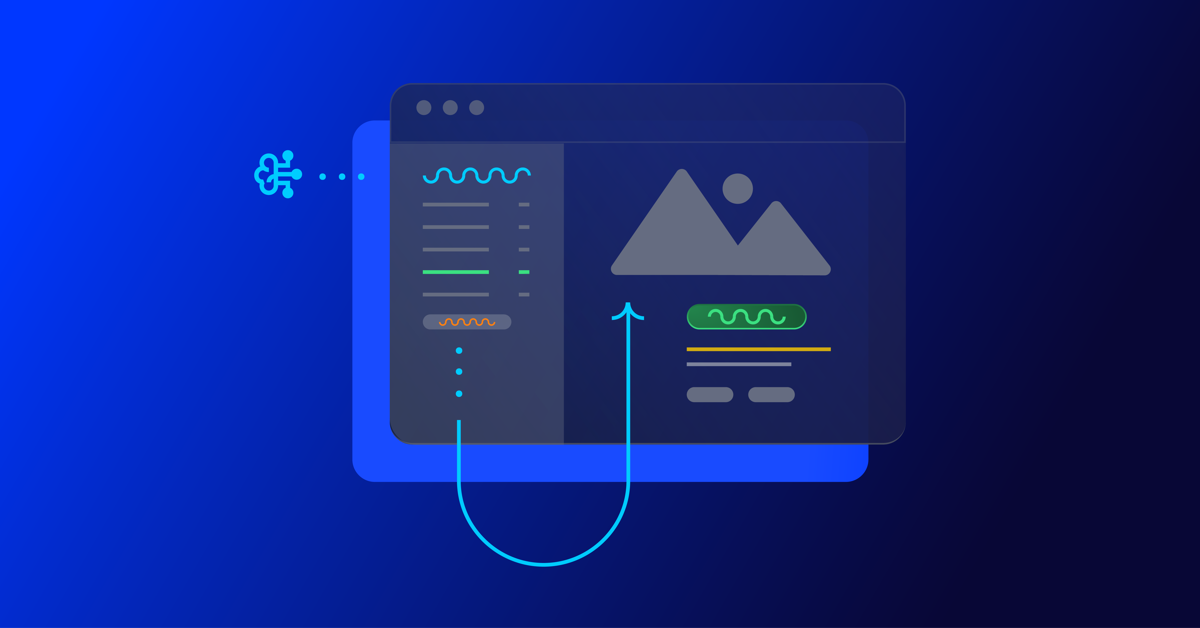
Before diving in to all things editorial guidelines, a quick introduction. I head up the content team here at Optimizely. I’m responsible for developing our content strategy and ensuring this aligns to our key business goals.
Here I’ll take you through the process we used to create new editorial guidelines; things that worked well and tackle some of the challenges that come with any good multi – stakeholder project, share some examples and leave you with a template you can use to set your own content standards.
What are editorial guidelines?
Editorial guidelines are a set of standards for any/all content contributors, etc. etc. This most often includes guidance on brand, tone of voice, grammar and style, your core content principles and the types of content you want to produce.
Editorial guidelines are a core component of any good content strategy and can help marketers achieve the following in their content creation process:
- Consistency: All content produced, regardless of who is creating it, maintains a consistent tone of voice and style, helping strengthen brand image and making it easier for your audience to recognize your company’s content
- Quality Control: Serves as a ‘North Star’ for content quality, drawing a line in the sand to communicate the standard of content we want to produce
- Boosts SEO efforts: Ensures content creation aligns with SEO efforts, improving company visibility and increasing traffic
- Efficiency: With clear guidelines in place, content creators – external and internal – can work more efficiently as they have a clear understanding of what is expected of them
Examples of editorial guidelines
There are some great examples of editorial guidelines out there to help you get started.
Here are a few I used:
1. Editorial Values and Standards, the BBC
Ah, the Beeb. This really helped me channel my inner journalist and learn from the folks that built the foundation for free quality journalism.
How to create editorial guidelines, Pepperland Marketing
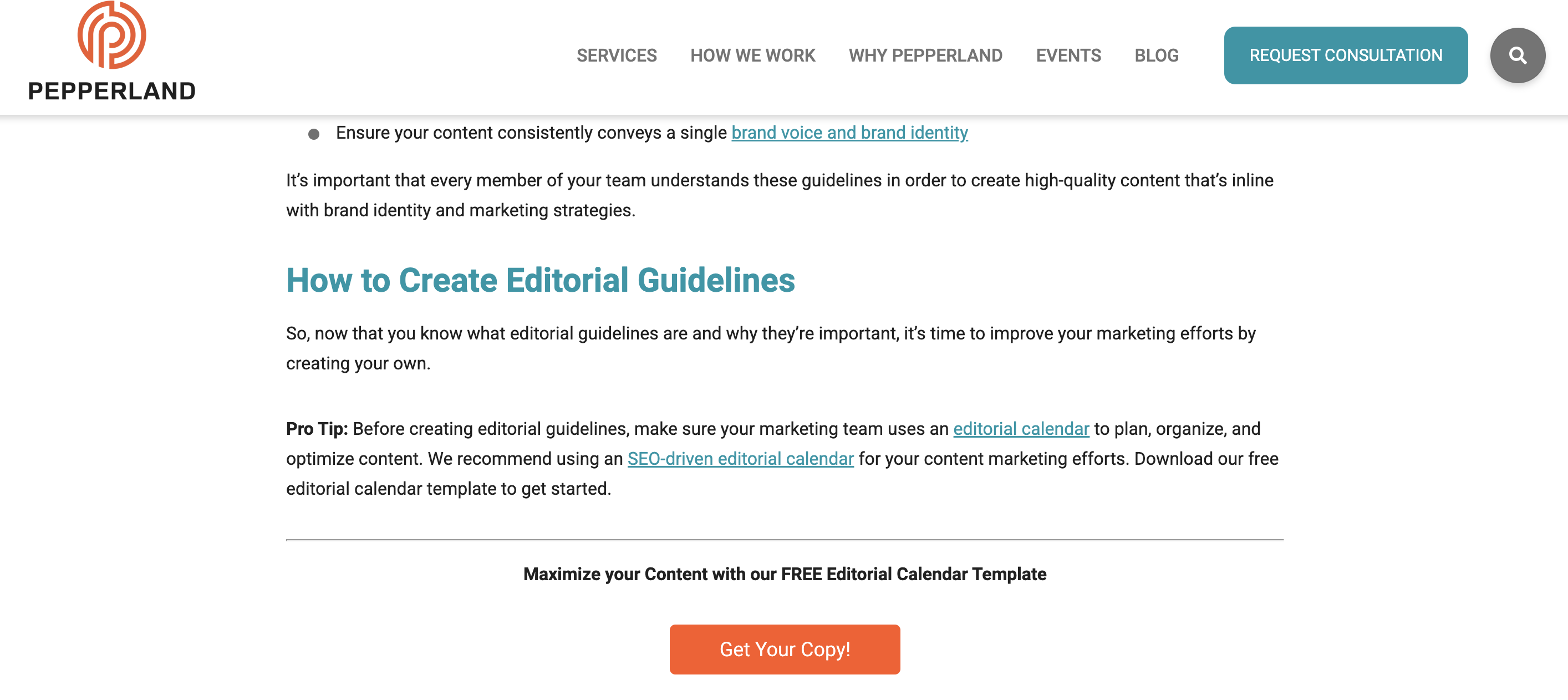
After taking a more big picture view I recognized needed more focused guidance on the step by step of creating editorial guidelines.
I really liked the content the good folks at Pepperland Marketing have created, including a free template – thanks guys! – and in part what inspired me to create our own free template as a way of sharing learnings and helping others quickstart the process of creating their own guidelines.
3. Writing guidelines for the role of AI in your newsroom?… Nieman Lab
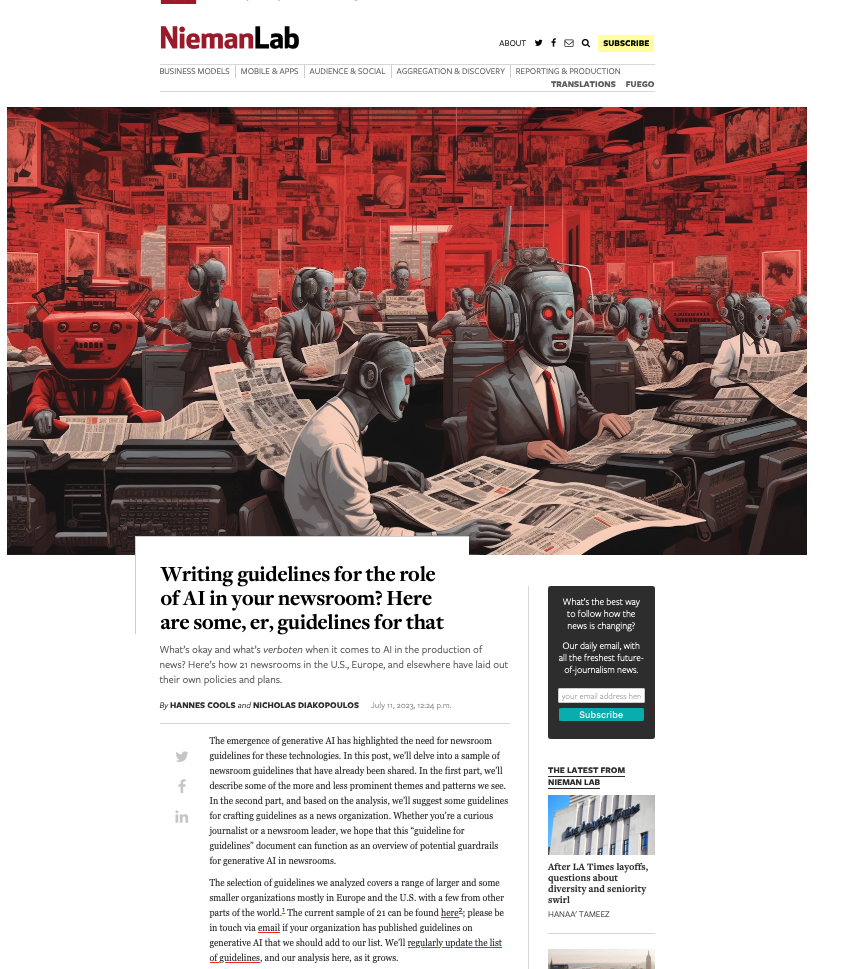
As well as provide guidance on content quality and the content creation process, I wanted to tackle the thorny topic of AI in our editorial guidelines. Specifically, to give content creators a steer on ‘fair’ use of AI when creating content, to ensure creators get to benefit from the amazing power of these tools, but also that content is not created 100% by AI and help them understand why we feel that contravenes our core content principles of content quality.
So, to learn more I devoured this fascinating article, sourcing guidance from major media outlets around the world. I know things change very quickly when it comes to AI, but I highly encourage reading this and taking inspiration from how these media outlets are tackling this topic.
Learn more: The Marketer’s Guide to AI-generated content
Why did we decide to create editorial guidelines?
1. Aligning content creators to a clear vision and process
Optimizely as a business has undergone a huge transformation over the last 3 years, going through rapid acquisition and all the joys and frustrations that can bring. As a content team, we quickly recognized the need to create a set of clear and engaging guidelines that helps content creators understand how and where they can contribute, and gave a clear process to follow when submitting a content idea for consideration.
2. Reinvigorated approach to brand and content
As a brand Optimizely is also going through a brand evolution – moving from a more formal, considered tone of voice to one that’s much more approachable, down to earth and not afraid to use humor, different in content and execution.
See, our latest CMS campaign creative:
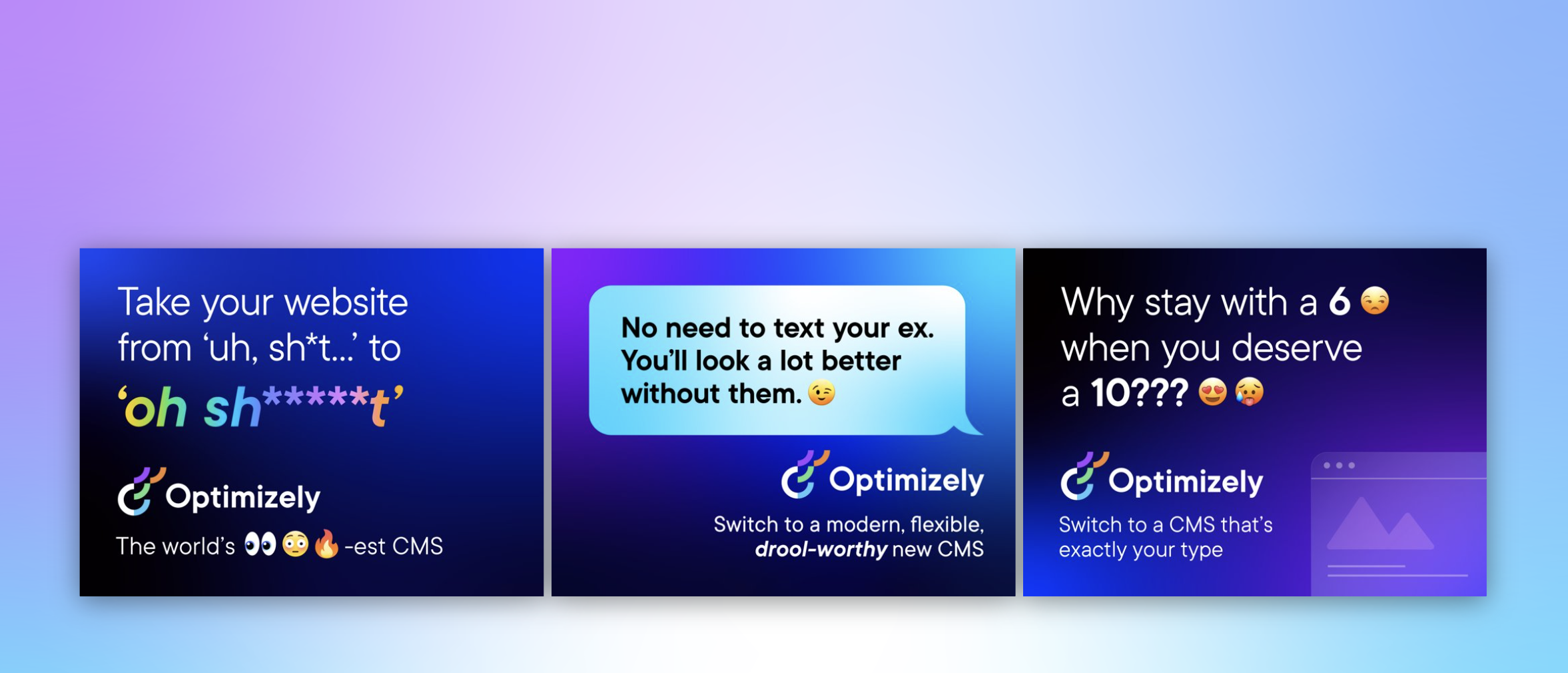
It’s pretty out there in terms of creative and messaging. It’s an ad campaign that’s designed to capture attention yes, but also – to demonstrate our abilities as a marketing team to create this type of campaign that is normally reserved for other more quote unquote creative industries.
We wanted to give guidance to fellow content creators outside the team on how they can also create content that embraces this evolved tone of voice, while at the same time ensuring content adheres to our brand guidelines.
3. Streamline content creation process
Like many global enterprises we have many different content creators, working across different time zones and locations. Documenting a set of guidelines and making them easily available helps content creators quickly understand our content goals, the types of content we want to create and why. It would free up content team time spent with individual contributors reviewing and editing submissions, and would ensure creation and optimization aligns to broader content & business goals.
It was also clear that we needed to document a process for submitting content ideas, so we made sure to include this in the guidelines themselves to make it easy and accessible for all contributors.
4. 2023 retrospective priority
As a content team we regularly review our content strategy and processes to ensure we’re operating as efficiently as possible.
In our last retrospective. I asked my team ‘what was the one thing I could do as a manager to help them be more impactful in their role?’
Editorial guidelines was the number 1 item on their list.
So off we went…
What we did
- Defined a discrete scope of work for the first version of the editorial guidelines, focusing on the Blog and Resources section of the website. This is where the content team spends most of its time and so has most involvement in the content creation process. Also where the most challenging bottlenecks have been in the past
- Research. Reviewed what was out there, got my hands on a few free templates and assembled a framework to create a first version for inputs and feedback
- Asked content community – I put a few questions out to my network on LinkedIn on the topic of content guidelines and content strategy, seeking to get input and guidance from smart marketers.

- Invited feedback: Over the course of a few weekswe invited collaborators to comment in a shared doc as a way of taking iterative feedback, getting ideas for the next scope of work, and also – bringing people on the journey of creating the guidelines. Look at all those reviewers! Doing this within our Content Marketing Platform (CMP) ensured that all that feedback was captured in one place, and that we could manage the process clearly, step by step:
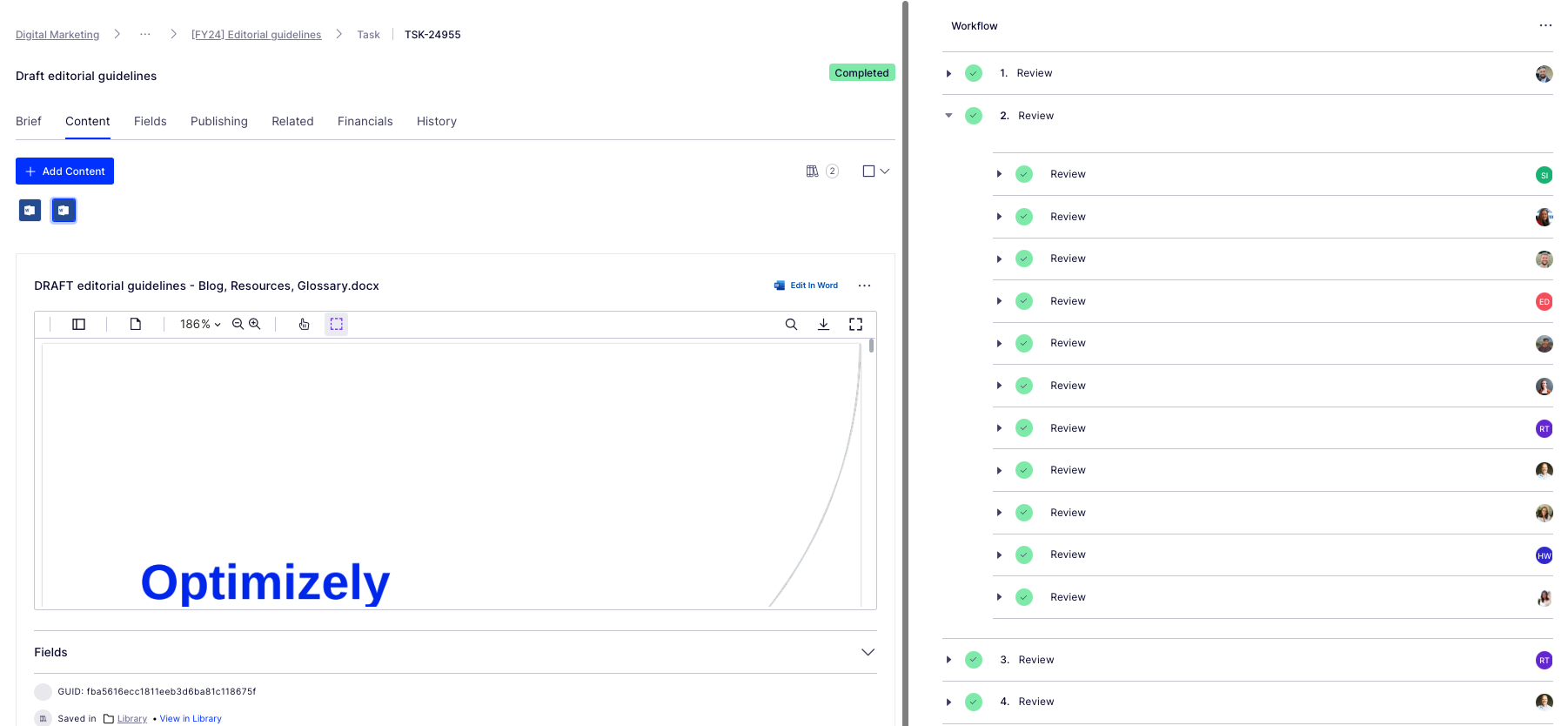
Look at all those collaborators! Thanks guys! And all of those beautiful ticks, so satisfying. So glad I could crop out the total outstanding tasks for this screen grab too (Source – Optimizely CMP)
- Updated content workflow: Now we have clear, documented guidance in place, we’ve included this as a step – the first step – in the workflow used for blog post creation:
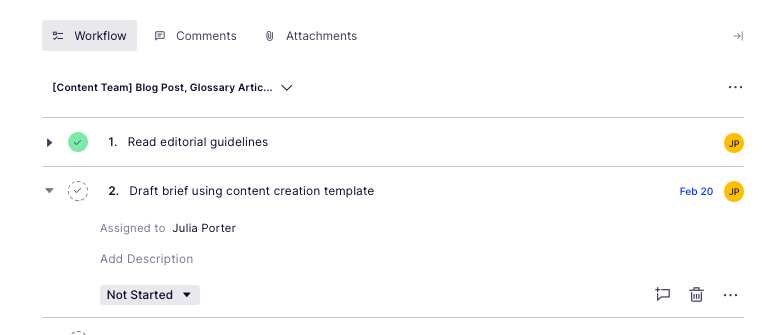
Source: Optimizely CMP
Results
It’s early days but we’re already seeing more engagement with the content creation process, especially amongst the teams involved in building the guidelines (which was part of the rationale in the first place :))

Source: My Teams chat
It’s inspired teams to think differently about the types of content we want to produce going forwards – for the blog and beyond.
I’d also say it’s boosted team morale and collaboration, helping different teams work together on shared goals to produce better quality work.
What’s next?
We’re busy planning wider communication of the editorial guidelines beyond marketing. We’ve kept the original draft and regularly share this with existing and potential collaborators for ongoing commentary, ideas and feedback.
Creating guidelines has also sparked discussion about the types of briefs and templates we want and need to create in CMP to support creating different assets. Finding the right balance between creative approach and using templates to scale content production is key.
We’ll review these guidelines on a quarterly basis and evolve as needed, adding new formats and channels as we go.
Key takeaways
- Editorial guidelines are a useful way to guide content creators as part of your overall content strategy
- Taking the time to do research upfront can help accelerate seemingly complex projects. Don’t be afraid to ask your community for inputs and advice as you create
- Keep the scope small at first rather than trying to align everything all at once. Test and learn as you go
- Work with stakeholders to build guidelines from the ground up to ensure you create a framework that is useful, relevant and used
And lastly, here’s that free template we created to help you build or evolve your own editorial guidelines!
MARKETING
Effective Communication in Business as a Crisis Management Strategy

Everyday business life is full of challenges. These include data breaches, product recalls, market downturns and public relations conflicts that can erupt at any moment. Such situations pose a significant threat to a company’s financial health, brand image, or even its further existence. However, only 49% of businesses in the US have a crisis communications plan. It is a big mistake, as such a strategy can build trust, minimize damage, and even strengthen the company after it survives the crisis. Let’s discover how communication can transform your crisis and weather the chaos.
The ruining impact of the crisis on business
A crisis can ruin a company. Naturally, it brings losses. But the actual consequences are far worse than lost profits. It is about people behind the business – they feel the weight of uncertainty and fear. Employees start worrying about their jobs, customers might lose faith in the brand they once trusted, and investors could start looking elsewhere. It can affect the brand image and everything you build from the branding, business logo, social media can be ruined. Even after the crisis recovery, the company’s reputation can suffer, and costly efforts might be needed to rebuild trust and regain momentum. So, any sign of a coming crisis should be immediately addressed. Communication is one of the crisis management strategies that can exacerbate the situation.
The power of effective communication
Even a short-term crisis may have irreversible consequences – a damaged reputation, high employee turnover, and loss of investors. Communication becomes a tool that can efficiently navigate many crisis-caused challenges:
- Improved trust. Crisis is a synonym for uncertainty. Leaders may communicate trust within the company when the situation gets out of control. Employees feel valued when they get clear responses. The same applies to the customers – they also appreciate transparency and are more likely to continue cooperation when they understand what’s happening. In these times, documenting these moments through event photographers can visually reinforce the company’s messages and enhance trust by showing real, transparent actions.
- Reputation protection. Crises immediately spiral into gossip and PR nightmares. However, effective communication allows you to proactively address concerns and disseminate true information through the right channels. It minimizes speculation and negative media coverage.
- Saved business relationships. A crisis can cause unbelievable damage to relationships with employees, customers, and investors. Transparent communication shows the company’s efforts to find solutions and keeps stakeholders informed and engaged, preventing misunderstandings and painful outcomes.
- Faster recovery. With the help of communication, the company is more likely to receive support and cooperation. This collaborative approach allows you to focus on solutions and resume normal operations as quickly as possible.
It is impossible to predict when a crisis will come. So, a crisis management strategy mitigates potential problems long before they arise.
Tips on crafting an effective crisis communication plan.
To effectively deal with unforeseen critical situations in business, you must have a clear-cut communication action plan. This involves things like messages, FAQs, media posts, and awareness of everyone in the company. This approach saves precious time when the crisis actually hits. It allows you to focus on solving the problem instead of intensifying uncertainty and panic. Here is a step-by-step guide.
Identify your crisis scenarios.
Being caught off guard is the worst thing. So, do not let it happen. Conduct a risk assessment to pinpoint potential crises specific to your business niche. Consider both internal and external factors that could disrupt normal operations or damage the online reputation of your company. Study industry-specific issues, past incidents, and current trends. How will you communicate in each situation? Knowing your risks helps you prepare targeted communication strategies in advance. Of course, it is impossible to create a perfectly polished strategy, but at least you will build a strong foundation for it.
Form a crisis response team.
The next step is assembling a core team. It will manage communication during a crisis and should include top executives like the CEO, CFO, and CMO, and representatives from key departments like public relations and marketing. Select a confident spokesperson who will be the face of your company during the crisis. Define roles and responsibilities for each team member and establish communication channels they will work with, such as email, telephone, and live chat. Remember, everyone in your crisis response team must be media-savvy and know how to deliver difficult messages to the stakeholders.
Prepare communication templates.
When a crisis hits, things happen fast. That means communication needs to be quick, too. That’s why it is wise to have ready-to-go messages prepared for different types of crises your company may face. These messages can be adjusted to a particular situation when needed and shared on the company’s social media, website, and other platforms right away. These templates should include frequently asked questions and outline the company’s general responses. Make sure to approve these messages with your legal team for accuracy and compliance.
Establish communication protocols.
A crisis is always chaotic, so clear communication protocols are a must-have. Define trigger points – specific events that would launch the crisis communication plan. Establish a clear hierarchy for messages to avoid conflicting information. Determine the most suitable forms and channels, like press releases or social media, to reach different audiences. Here is an example of how you can structure a communication protocol:
- Immediate alert. A company crisis response team is notified about a problem.
- Internal briefing. The crisis team discusses the situation and decides on the next steps.
- External communication. A spokesperson reaches the media, customers, and suppliers.
- Social media updates. A trained social media team outlines the situation to the company audience and monitors these channels for misinformation or negative comments.
- Stakeholder notification. The crisis team reaches out to customers and partners to inform them of the incident and its risks. They also provide details on the company’s response efforts and measures.
- Ongoing updates. Regular updates guarantee transparency and trust and let stakeholders see the crisis development and its recovery.
Practice and improve.
Do not wait for the real crisis to test your plan. Conduct regular crisis communication drills to allow your team to use theoretical protocols in practice. Simulate different crisis scenarios and see how your people respond to these. It will immediately demonstrate the strong and weak points of your strategy. Remember, your crisis communication plan is not a static document. New technologies and evolving media platforms necessitate regular adjustments. So, you must continuously review and update it to reflect changes in your business and industry.
Wrapping up
The ability to handle communication well during tough times gives companies a chance to really connect with the people who matter most—stakeholders. And that connection is a foundation for long-term success. Trust is key, and it grows when companies speak honestly, openly, and clearly. When customers and investors trust the company, they are more likely to stay with it and even support it. So, when a crisis hits, smart communication not only helps overcome it but also allows you to do it with minimal losses to your reputation and profits.
MARKETING
Should Your Brand Shout Its AI and Marketing Plan to the World?

To use AI or not to use AI, that is the question.
Let’s hope things work out better for you than they did for Shakespeare’s mad Danish prince with daddy issues.
But let’s add a twist to that existential question.
CMI’s chief strategy officer, Robert Rose, shares what marketers should really contemplate. Watch the video or read on to discover what he says:
Should you not use AI and be proud of not using it? Dove Beauty did that last week.
Should you use it but keep it a secret? Sports Illustrated did that last year.
Should you use AI and be vocal about using it? Agency giant Brandtech Group picked up the all-in vibe.
Should you not use it but tell everybody you are? The new term “AI washing” is hitting everywhere.
What’s the best option? Let’s explore.
Dove tells all it won’t use AI
Last week, Dove, the beauty brand celebrating 20 years of its Campaign for Real Beauty, pledged it would NEVER use AI in visual communication to portray real people.
In the announcement, they said they will create “Real Beauty Prompt Guidelines” that people can use to create images representing all types of physical beauty through popular generative AI programs. The prompt they picked for the launch video? “The most beautiful woman in the world, according to Dove.”
I applaud them for the powerful ad. But I’m perplexed by Dove issuing a statement saying it won’t use AI for images of real beauty and then sharing a branded prompt for doing exactly that. Isn’t it like me saying, “Don’t think of a parrot eating pizza. Don’t think about a parrot eating pizza,” and you can’t help but think about a parrot eating pizza right now?
Brandtech Group says it’s all in on AI
Now, Brandtech Group, a conglomerate ad agency, is going the other way. It’s going all-in on AI and telling everybody.
This week, Ad Age featured a press release — oops, I mean an article (subscription required) — with the details of how Brandtech is leaning into the takeaway from OpenAI’s Sam Altman, who says 95% of marketing work today can be done by AI.
A Brandtech representative talked about how they pitch big brands with two people instead of 20. They boast about how proud they are that its lean 7,000 staffers compete with 100,000-person teams. (To be clear, showing up to a pitch with 20 people has never been a good thing, but I digress.)
OK, that’s a differentiated approach. They’re all in. Ad Age certainly seemed to like it enough to promote it. Oops, I mean report about it.
False claims of using AI and not using AI
Offshoots of the all-in and never-will approaches also exist.
The term “AI washing” is de rigueur to describe companies claiming to use AI for something that really isn’t AI. The US Securities and Exchange Commission just fined two companies for using misleading statements about their use of AI in their business model. I know one startup technology organization faced so much pressure from their board and investors to “do something with AI” that they put a simple chatbot on their website — a glorified search engine — while they figured out what they wanted to do.
Lastly and perhaps most interestingly, companies have and will use AI for much of what they create but remain quiet about it or desire to keep it a secret. A recent notable example is the deepfake ad of a woman in a car professing the need for people to use a particular body wipe to get rid of body odor. It was purported to be real, but sharp-eyed viewers suspected the fake and called out the company, which then admitted it. Or was that the brand’s intent all along — the AI-use outrage would bring more attention?
This is an AI generated influencer video.
Looks 100% real. Even the interior car detailing.
UGC content for your brand is about to get really cheap. ☠️ pic.twitter.com/2m10RqoOW3
— Jon Elder | Amazon Growth | Private Label (@BlackLabelAdvsr) March 26, 2024
To yell or not to yell about your brand’s AI decision
Should a brand yell from a mountaintop that they use AI to differentiate themselves a la Brandtech? Or should a brand yell they’re never going to use AI to differentiate themselves a la Dove? Or should a brand use it and not yell anything? (I think it’s clear that a brand should not use AI and lie and say it is. That’s the worst of all choices.)
I lean far into not-yelling-from-mountaintop camp.
When I see a CEO proudly exclaim that they laid off 90% of their support workforce because of AI, I’m not surprised a little later when the value of their service is reduced, and the business is failing.
I’m not surprised when I hear “AI made us do it” to rationalize the latest big tech company latest rounds of layoffs. Or when a big consulting firm announces it’s going all-in on using AI to replace its creative and strategic resources.
I see all those things as desperate attempts for short-term attention or a distraction from the real challenge. They may get responses like, “Of course, you had to lay all those people off; AI is so disruptive,” or “Amazing. You’re so out in front of the rest of the pack by leveraging AI to create efficiency, let me cover your story.” Perhaps they get this response, “Your company deserves a bump in stock price because you’re already using this fancy new technology.”
But what happens if the AI doesn’t deliver as promoted? What happens the next time you need to lay off people? What happens the next time you need to prove your technologically forward-leaning?
Yelling out that you’re all in on a disruptive innovation, especially one the public doesn’t yet trust a lot is (at best) a business sugar high. That short-term burst of attention may or may not foul your long-term brand value.
Interestingly, the same scenarios can manifest when your brand proclaims loudly it is all out of AI, as Dove did. The sugar high may not last and now Dove has itself into a messaging box. One slip could cause distrust among its customers. And what if AI gets good at demonstrating diversity in beauty?
I tried Dove’s instructions and prompted ChatGPT for a picture of “the most beautiful woman in the world according to the Dove Real Beauty ad.”
It gave me this. Then this. And this. And finally, this.
She’s absolutely beautiful, but she doesn’t capture the many facets of diversity Dove has demonstrated in its Real Beauty campaigns. To be clear, Dove doesn’t have any control over generating the image. Maybe the prompt worked well for Dove, but it didn’t for me. Neither Dove nor you can know how the AI tool will behave.
To use AI or not to use AI?
When brands grab a microphone to answer that question, they work from an existential fear about the disruption’s meaning. They do not exhibit the confidence in their actions to deal with it.
Let’s return to Hamlet’s soliloquy:
Thus conscience doth make cowards of us all;
And thus the native hue of resolution
Is sicklied o’er with the pale cast of thought,
And enterprises of great pith and moment
With this regard their currents turn awry
And lose the name of action.
In other words, Hamlet says everybody is afraid to take real action because they fear the unknown outcome. You could act to mitigate or solve some challenges, but you don’t because you don’t trust yourself.
If I’m a brand marketer for any business (and I am), I’m going to take action on AI for my business. But until I see how I’m going to generate value with AI, I’m going to be circumspect about yelling or proselytizing how my business’ future is better.
HANDPICKED RELATED CONTENT:
Cover image by Joseph Kalinowski/Content Marketing Institute
-

 PPC7 days ago
PPC7 days ago19 Best SEO Tools in 2024 (For Every Use Case)
-
SEARCHENGINES6 days ago
Daily Search Forum Recap: April 19, 2024
-
SEARCHENGINES7 days ago
Daily Search Forum Recap: April 18, 2024
-

 WORDPRESS6 days ago
WORDPRESS6 days agoHow to Make $5000 of Passive Income Every Month in WordPress
-

 SEO7 days ago
SEO7 days ago25 WordPress Alternatives Best For SEO
-

 WORDPRESS5 days ago
WORDPRESS5 days ago13 Best HubSpot Alternatives for 2024 (Free + Paid)
-

 WORDPRESS6 days ago
WORDPRESS6 days ago7 Best WooCommerce Points and Rewards Plugins (Free & Paid)
-

 MARKETING6 days ago
MARKETING6 days agoBattling for Attention in the 2024 Election Year Media Frenzy




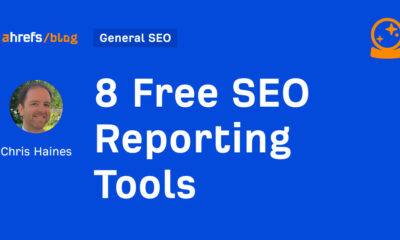

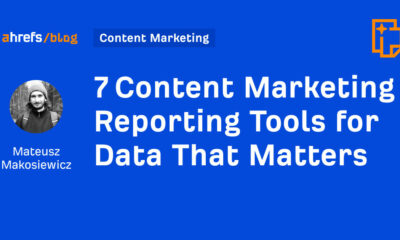







You must be logged in to post a comment Login